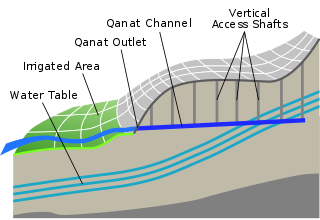Bayazeh بياضه | |
|---|---|
Village | |
| Coordinates: 33°20′05″N55°06′13″E / 33.33472°N 55.10361°E Coordinates: 33°20′05″N55°06′13″E / 33.33472°N 55.10361°E | |
| Country | |
| Province | Isfahan |
| County | Khur and Biabanak |
| Bakhsh | Central |
| Rural District | Nakhlestan |
| Population (2006) | |
| • Total | 319 |
| Time zone | UTC+3:30 (IRST) |
| • Summer (DST) | UTC+4:30 (IRDT) |
Bayazeh (Persian : بياضه, also Romanized as Bayāẕeh, Bayāzeh, and Baiāzeh; also known as Bayāzīyeh and Bīabānāk) [1] is a village in Nakhlestan Rural District, in the Central District of Khur and Biabanak County, Isfahan Province, Iran. It was founded more than 2,500 years ago.

Persian, also known by its endonym Farsi, is one of the Western Iranian languages within the Indo-Iranian branch of the Indo-European language family. It is primarily spoken in Iran, Afghanistan, and Tajikistan, Uzbekistan and some other regions which historically were Persianate societies and considered part of Greater Iran. It is written right to left in the Persian alphabet, a modified variant of the Arabic script.
Nakhlestan Rural District is a rural district (dehestan) in the Central District of Khur and Biabanak County, Isfahan Province, Iran. At the 2006 census, its population was 2,396, in 740 families. The rural district has 14 villages.
The Central District of Khur and Biabanak County is a district (bakhsh) in Khur and Biabanak County, Isfahan Province, Iran. At the 2006 census, its population was 17,488, in 4,924 families. The District has four cities: Khur and Biabanak, Kushk, Dorcheh Piaz & Farrokhi. The District has three rural districts (dehestan): Biabanak Rural District, Jandaq Rural District, and Nakhlestan Rural District.
At the 2006 census, its population was 319 people, in 103 families. [2]
According to some reports, the population of this village had been around 5,000 people in the past. Bayazeh has been known as the cultural and scientific center of this part of the desert. Many greats and scientists have lived there.
Saghafi' (from Mukhtar Saghafi) have been the most famous family in this village.

Mukhtār ibn Abī ʿUbayd al-Thaqafī was a pro-Alid revolutionary based in Kufa, who led a rebellion against the Umayyads and ruled over most of Iraq for eighteen months during the Second Islamic Civil War.
An ancient old castle (remaining from the Sasanian empire or before), mosques, houses, covered narrow alleys, and a qanat, are all sites that attract tourists.

The Sasanian Empire, also known as the Sassanian, Sasanid, Sassanid or Neo-Persian Empire, was the last kingdom of the Persian Empire before the rise of Islam. Named after the House of Sasan, it ruled from 224 to 651 AD. The Sasanian Empire succeeded the Parthian Empire and was recognised as one of the leading world powers alongside its neighbouring arch-rival the Roman-Byzantine Empire for a period of more than 400 years.

A qanāt or kārīz is a gently sloping underground channel to transport water from an aquifer or water well to surface for irrigation and drinking. This is an old system of water supply from a deep well with a series of vertical access shafts. The qanats still create a reliable supply of water for human settlements and irrigation in hot, arid, and semi-arid climates, but the value of this system is directly related to the quality, volume, and regularity of the water flow. Traditionally qanats are built by a group of skilled laborers, muqannīs, with hand labor. The profession historically paid well and was typically handed down from father to son. According to most sources, the qanat technology was developed in ancient Iran by the Persian people sometime in the early 1st millennium BC, and spread from there slowly westward and eastward. However, some other sources suggest a Southeast Arabian origin.

